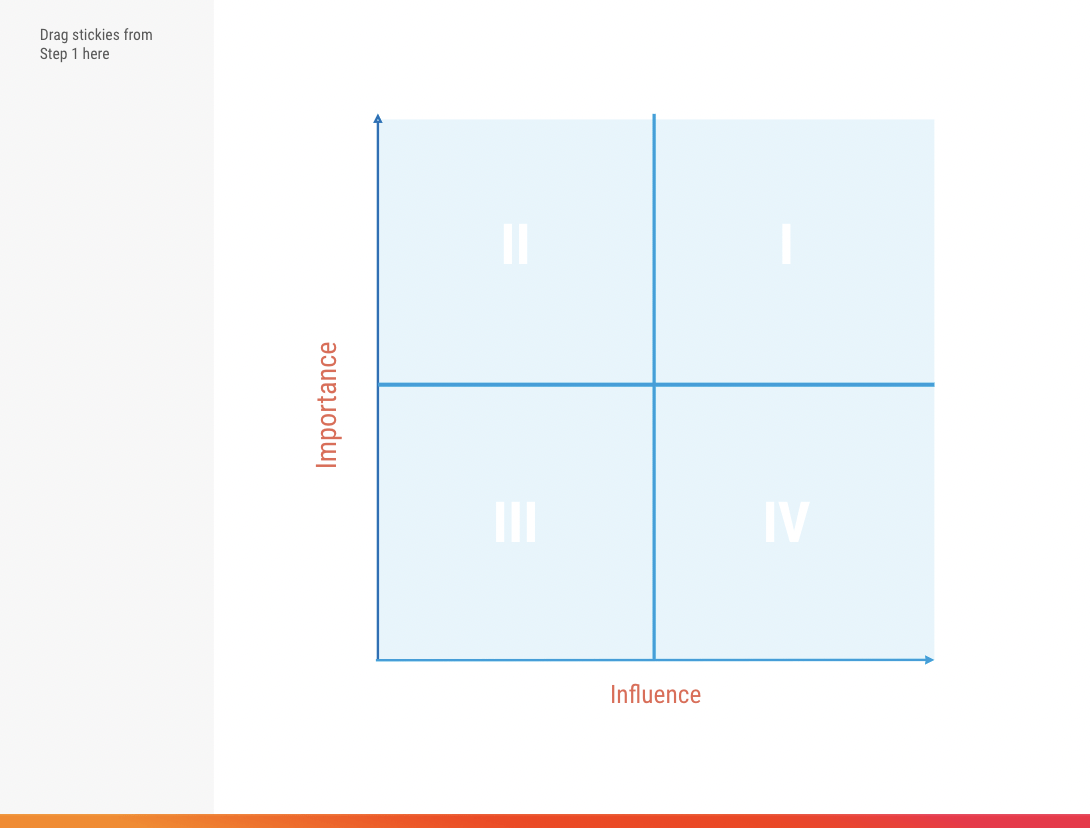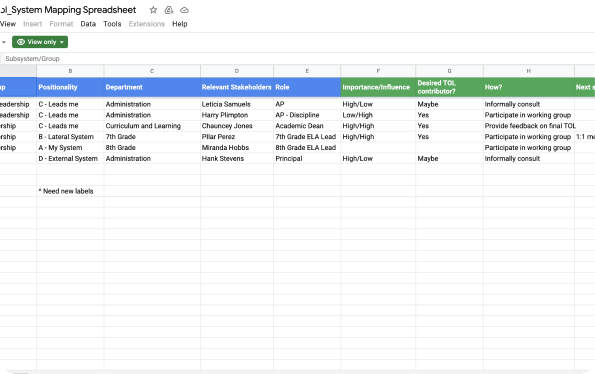Identify Your Theory-Building Team
Timing - 90 Minutes
In this activity, you will map relevant stakeholders and identify a core team for your Theory of Leadership development process.
Back to Phase 1 overviewOverview
Now that you have mapped out relevant actors in your system, it is time to identify those with whom you will work most closely to develop your Theory.
The strongest learning happens in partnership with others, and we recommend developing your Theory in collaboration with those who:
- will experience your work from different vantage points and hold different roles (e.g., ground-level staff, positional leaders, young people, families, community members);
- have institutional knowledge of your system and can offer outside perspectives on your work; and
- have varied racial, cultural, and socioeconomic perspectives.
Use the Theory of Leadership Team activity template to map out all relevant stakeholders on an Influence X Importance matrix, and identify a core group of contributors. Then return to your system mapping spreadsheet, clarify the role each person will play, and identify the steps you will take to request their participation and get started with your shared work. Throughout your process, you should continually reassess your stakeholder pool, staying flexible and inviting in new collaborators when necessary.
Let’s get started.
Tools & Materials
Need support? Learn more about working with CPRL.
Protocol
Gather the stakeholder sticky notes you added to your System Map in Step 1.
Position each sticky note on the Influence X Importance Matrix activity template based on the stakeholder’s level of influence on and importance to your Theory of Leadership.
An Influence X Importance matrix can help you determine which stakeholders you will need to support your Theory of Leadership effort and whose needs you should consider in its design and implementation. For purposes of this exercise, influence is defined as the degree to which a stakeholder can facilitate or hinder progress toward your goal; importance is the priority given to satisfying a stakeholder’s needs.
Consider the stakeholders in each quadrant.
How can you engage quadrant I (high influence, high importance) stakeholders in your Theory development process and leverage their high degree of influence and importance?
Consider that pink sticky notes are stakeholders you directly manage, green sticky are those you share dependencies with, blue are those you report to, and yellow are those outside your immediate system or organization. How will your engagement approach need to change for each of those stakeholder types?
What about quadrants II and IV? Consider again the color of your sticky notes and how your approach to engagement may need to change for each type of stakeholder.
As you analyze your matrix, update columns F through I on your stakeholder mapping spreadsheet.
Column F: Record how you positioned this stakeholder on your Influence X Importance matrix.
Column G: Note whether you will engage this stakeholder in your Theory of Leadership development process.
Column H: If you are engaging this stakeholder in your Theory development process, note how you plan to engage them. Will they be a member of a formal Theory of Leadership planning team? Will they consult and offer feedback at defined points throughout your process? Will they act as an informal thought partner? As you make decisions about the role each stakeholder will play, consider:
- Buy-In: Will the implementation of your approach be more successful if this stakeholder feels ownership of and buy-in to your leadership approach?
- Authority: Will this stakeholder need to sign off on any of your plans?
- Bandwidth: How much time and capacity does this stakeholder have to contribute?
- Expertise: On what topics will this stakeholder bring critical expertise?
Column I: Note your next steps for recruiting each selected stakeholder.
Once you’ve completed your analysis and finished your list, filter Column G so that only stakeholders you have identified as desired collaborators are visible.
Consider your list. Have you identified a group of contributors that includes:
- actors who will experience your work from different vantage points and roles?
- both long-term staff with historically-informed understandings of your system and newer hires who can offer fresh perspectives on your work?
- actors with varied racial, cultural, and socioeconomic perspectives?
If not, un-filter your list and determine which other stakeholders you might invite to participate in your Theory of Leadership development process.
Once complete, get to work recruiting stakeholders!


